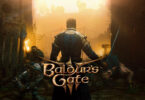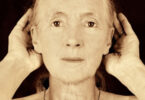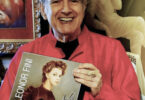Today, when we hear so much about “fake news,” truth becomes increasingly important. Poets John Keats and Emily Dickinson both examined its nature, Dickinson finding that its beauty “dazzles gradually.” We know Art, as it exists, lives beyond mortals, shining with beauty, giving humanity a real cultural record.
The recent Fourth International Residency at The Red Barn in Beacon, NY, featured three painters and a photographer who individually wrestled with this profound subject making work varied and emotional, connecting the viewer thoughtfully and intimately to it. Curator Basha Maryanska, the residency’s driving force, also participated as one of the artists and encouraged Sandy Brown, a newcomer, Neela Pushparaj, a veteran, and photographer, Mietko Rudek to create work strong and superb where all pieces are significant examples of truth and beauty; lasting documentations of the human spirit to be savored in succeeding years.
First time participant Sandy Brown, is a watercolorist, originally hailed from Chicago, living and working professionally as a math teacher there. Brown has spent her life giving to people and told me the residency allowed her time to work for an extended period without distractions, thus producing a cohesive body of work. In her pieces, she applies transparent films of water paint, sometimes up to twenty layers, onto the surface of the paper. Pigments are manipulated by use of the edge of a credit card rather than palette knife as she works intuitively, producing results from observations of her surroundings. Emotional force comes from the hard edges created through her scraping of paints, contrasting credit card induced sharp lines with sensitive underlying diaphanous pigment.
Brown interprets the magnificent Hudson Valley and also paints her memories of Chicago, providing dramatic river scenes and urban landscapes with strong geometric patterns. A bustling maelstrom is found in her painting, “Rush Hour,” the strokes of opaque brown, white and gray giving a frenetic sense to traffic speeding in city viaducts. Paint strokes horizontally dash across the lower third of the composition, contrasting with vertical skyscrapers pushing upward on the horizon toward elongated curls of chalky white tinted sky, the direction of the clouds’ sweep echoing the horizontal movement of the umber gestures in the lower part of the piece. Here, the artist is able to make the quick pace of the city palpable to the viewer in all its imposing gritty drama.
Drama also carries over into her watercolor “Fractured,” an interpretation of the Hudson Valley as a storm approaches. In this piece, the expanding layers of cool landscape colors are punctuated by the artist’s working of lines of lightning, their sharp delineations attacking the billowing blue and white clouds. The idyllic greenery of the valley contrasts, with jaggedlined intimations of mountains and rock forms subsumed in the giant clouds, are Brown’s profound interpretation of the coming storm, her testament to the magnificent truth of nature.
The photographer in the residency, “Mietko” Rudek, creates interpretations of the urban scene where he transforms the grimy modern city’s reality into idealized visions of metropolitan beauty. His pictures of New York City, the elevated train tracks cutting through Queens, his home turf, and the ribbons of rails sinuously curving toward the horizon of tall distant buildings, are romanticized as silhouettes in the setting sun. Mietko does not like to place people in his photographs, instead allowing the images to become abstracted documents of the trajectory of his life that runs from Poland to Paris and New York. His camera captures impressions of whatever environment his eyes see, the subjects accidental, so that the images have spontaneity.
Mostly self-taught, he says his photographs are results of experiments in the school of life, the fruitions of his optical battle with color, now realized through his use of the iPhone. This manufactured reality is seductive where the steel of the city is idealized into semi-abstract vignettes, his goal being to tell his own truth. This is very important to him as he came to the United States during the dissolution of the Soviet empire and greatly values his opportunity to create images more freely and honestly than what he could do in his former homeland.
His group of photos, “City Series,” turns a ride in an elevated subway car into semi-abstracted studies of moving scenery, where cold steel becomes painterly vision, softening the metal’s indifference into streams of gentle light. The first image in the series is the most geometric, Mietko paying homage to America in his inclusion of a U.S. flag from a passing train’s side as part of the picture. The piece’s depiction of steel gradually changes into images outside the train that are quasi- pastoral, with shafts of light from the windows intimate sheer overlaying curtains, transforming the urban imagery into organic beauty. Although people are not his primary subjects, Mietko is a humanist where his objective subject matter acquires emotional resonance.
Neela Pushparaj, a returning participant to the residency, finds great truth and beauty this time where her experience becomes one of healing as she continues her recovery from her husband’s death. Pushparaj was grateful to Maryanska for the opportunity to spend time in Beacon where she found space to paint through her sorrow. Her major work, “Opus 84,” is a watercolor floral on canvas of effusive brights, the washes of blooms flowing from the painter’s brush and integrated with delicate expressive lines. The painting, a celebration of her husband’s life, the title referring to his age at the time of his passing, has line work indicative of branches, more integrated with the flowers than in a previous canvas about the same subject, entitled “Goodbye My Love.” Here, the act of painting helps Pushparaj to process this tragic event in her life.
“Opus 84,” with a trompe l’oeil quality to it, has florals appearing to be more loosely painted than usual on a decal edged paper, although it is really canvas. Pushparaj seems to float the flowers on top of the surface, charting new territory as she makes truth of feeling more accessible to the viewer and amplifies her breadth of technique.
Basha Maryanska, the driving force behind the residency, exhibits strong work of expressive color handling of landscape elements, tempered by chill darks and lights. Her passionate feelings are characterized by messages of concern about the environment, her creative gifts examining her thoughts about the future.
The painting, “River Warnings,” collages a thermometer dead-center on a bleak canvas, the paint reflecting winter with white and gray dramatic brushstrokes. I interpreted it as signifying the artist’s fears, so the message is perhaps that with a warming planet and rising sea, the artist’s beautiful Hudson Valley may just become a memory of the past.
Maryanska told me her imagery comes first from her feelings of love about landscape that she brings forth with pigment, brush and palette knife. Like the other painters in this residency, her works arise intuitively and are reflective of the world around her, providing her an opportunity to name her feelings. She finds it increasingly difficult to find portrayals of honest feelings in art today, as much of it is characterized by visual propaganda, so that for her the chance to support honest human expression, through her artists, gains increasing significance with each passing hour.
She found happier expression in the mixed media piece, “Heart and Soul,” a work about hope and love of life, where a collaged cornucopia of exuberant blue painted fragments spill out across the surface with a great valentine, symbolic of Maryanska’s heart, slapped on the upper left quadrant of the work. This highly energetic piece seems to be the artist’s love letter to humanity in its many layers of paint and metallic gold varnishes on blue; the work serving as Maryanska’s statement that there is a bright future for humankind if all people come together to truly face today’s challenges.
Ultimately, truth and beauty cannot be totally quantified. Maryanska and her artists know this and are able here to find personal opportunities to candidly express themselves, making their emotions as beautifully real as possible. There is nothing false or removed in their portrayals of human feeling. In Beacon, N.Y., one artist found time to devote to her own creativity, one found healing, one found honesty, and another freedom. Each provided testimony to the power of art to document the truth and beauty of the human soul without malice or lies, sending forth emotional information knowingly, providing goodness and splendor in the Red Barn’s sheltering space.
4th International Artists Residency Recently seen at The Red Barn – River Center 8 Long Dock Road, Beacon, N.Y.




